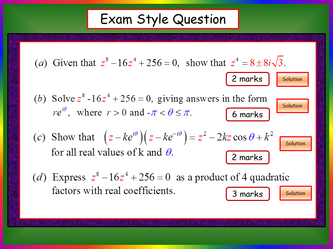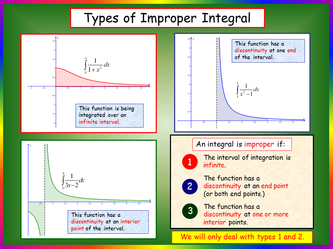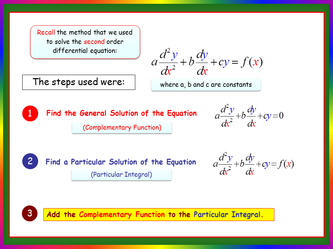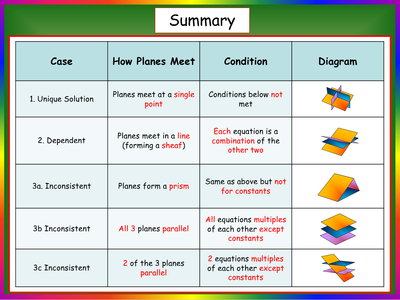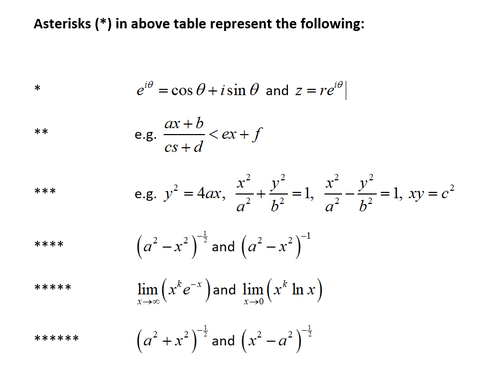Superb PowerPoint Teaching Resources for Teachers of A-Level Further Maths
"...student friendly and should be in every school in the UK!"
A selection of some of the most outstanding and inspiring mathematicians in history.
What is 'Teach Further Maths'?
Written for teachers, 'Teach Further Maths' is a suite of high quality, fully animated colour A-Level Further Maths PowerPoint presentations, consisting of over 3000 slides.
Written by a very experienced classroom practitioner, examiner and published maths author (Paul Hunt), the presentations include demonstrations, proofs, worked examples, exercises, exam-style questions and actual exam questions (used with permission).
'Teach Further Maths' is perfect for the new specifications and already includes most of the compulsory content from all of the main examination boards.
Written by a very experienced classroom practitioner, examiner and published maths author (Paul Hunt), the presentations include demonstrations, proofs, worked examples, exercises, exam-style questions and actual exam questions (used with permission).
'Teach Further Maths' is perfect for the new specifications and already includes most of the compulsory content from all of the main examination boards.
Which topics does 'Teach Further Maths' cover?
Teach Further Maths now includes full, detailed coverage of EVERY topic from the compulsory content that teachers now have to deliver.
All 4 of the main exam boards are now completely catered for!
(see the table below for details of the compulsory A-Level Further Mathematics content for each of Edexcel, AQA, OCR and MEI).
All 4 of the main exam boards are now completely catered for!
(see the table below for details of the compulsory A-Level Further Mathematics content for each of Edexcel, AQA, OCR and MEI).
Screenshots from 'Teach Further Maths':
A small sample of what to expect from 'Teach Further Maths':
Can I try before I buy?
Not as such, but we do offer a completely free Sample presentation (from the A-Level Mathematics specification) so that you can experience the high quality of presentations that 'Teach Further Maths' offers you.
Compulsory A-Level Further Mathematics content by exam board
Topic |
Content |
Edexcel |
AQA |
OCR 'A' |
MEI |
Proof |
Construct proofs by mathematical induction |
Included |
Included |
Included |
Included |
Complex Numbers |
Solve any quadratic with real coefficients |
Included |
Included |
Included |
Included |
Complex Numbers |
Solve cubic or quartic equations with real coefficients |
Included |
Included |
Included |
Included |
Complex Numbers |
Add, subtract, multiply and divide complex numbers; understand the terms 'real' part and 'imaginary' part, 'modulus' and 'argument' |
Included |
Included |
Included |
Included |
Complex Numbers |
Understand and use the complex conjugate; know that non-real roots of polynomials equations with real coefficients occur in conjugate pairs |
Included |
Included |
Included |
Included |
Complex Numbers |
Use and interpret Argand diagrams |
Included |
Included |
Included |
Included |
Complex Numbers |
Convert between Cartesian form and Modulus-Argument form of a complex number |
Included |
Included |
Included |
Included |
Complex Numbers |
Multiply and divide complex numbers in modulus-argument form |
Included |
Included |
Included |
Included |
Complex Numbers |
Construct and interpret simple loci in an Argand diagram. |
Included |
Included |
Included |
Included |
Complex Numbers |
Know and use both forms of Euler's formula (*) |
Included |
Included |
Included |
Included |
Complex Numbers |
Understand and use DeMoivre's Theorem and use it to find the multiple angle formulae and sums of series |
Included |
Included |
Included |
Included |
Complex Numbers |
Find the nth roots of any complex number and know that they form the vertices of a regular n-sided polygon in the Argand diagram |
Included |
Included |
Included |
Included |
Complex Numbers |
Use complex roots of unity to solve geometric problems |
Included |
Included |
Included |
Included |
Matrices |
Add, subtract and multiply conformable matrices; multiply a matrix by a scalar |
Included |
Included |
Included |
Included |
Matrices |
Understand and use zero and identity matrices |
Included |
Included |
Included |
Included |
Matrices |
Know that matrix multiplication is associative but not commutative |
Included |
Included |
Included |
Included |
Matrices |
Find and use matrices to represent linear transformations in 2D (including simple shears); successive transformations; 3D transformations confined to simple cases only |
Included |
Included |
Included |
Included |
Matrices |
Find invariant points and lines for a linear transformation |
Included |
Included |
Included |
Included |
Matrices |
Find the determinant of 2 x 2 and 3 x 3 matrices. |
Included |
Included |
Included |
Included |
Matrices |
Know that the determinant of a 2 x 2 matrix is the area scale factor of the associated transformation and interpret the sign of the determinant in terms of the orientation of the image. |
Included |
Included |
Included |
Included |
Matrices |
Calculate the inverse of 2 x 2 and 3 x 3 non-singular matrices |
Included |
Included |
Included |
Included |
Matrices |
Solve 3 simultaneous linear equations in 2 variables by use of the inverse matrix |
Included |
Included |
Included |
Included |
Matrices |
Interpret geometrically the solution and failure of solution of 3 simultaneous equations |
Included |
Included |
Included |
Included |
Matrices |
Factorisation of determinants using row and column operations |
N/A |
Included |
N/A |
N/A |
Matrices |
Find the eigenvalues and eigenvectors of 2 x 2 and 3 x 3 matrices; find and use the characteristic equation |
N/A |
Included |
N/A |
N/A |
Matrices |
Diagonalise matrices |
N/A |
Included |
N/A |
N/A |
Further Algebra |
Understand and use the relationship between roots and coefficients of polynomial equations up to quartic equations. |
Included |
Included |
Included |
Included |
Further Algebra |
Form a polynomial equation whose roots are a linear transformation of the roots of a given polynomial |
Included |
Included |
Included |
Included |
Further Algebra |
Understand and use formulae for sums of integers, squares and cubes and use these to sum other series |
Included |
Included |
Included |
Included |
Further Algebra |
Understand and use the method of differences for summation of series including use of partial fractions |
Included |
Included |
Included |
Included |
Further Algebra |
Find the MacLaurin series of a function, including its general term |
Included |
Included |
Included |
Included |
Further Algebra |
Recognise and use Maclaurin series for certain functions and be aware of their range of validity |
Included |
Included |
Included |
Included |
Further Algebra |
Evaluation of limits using MacLaurin series (L'Hopital's Rule also included) |
Included |
Included |
Included |
Included |
Further Algebra |
Inequalities involving polynomial equations (cubic and quartic) |
N/A |
Included |
N/A |
N/A |
Further Algebra |
Solving rational inequalities algebraically (**) |
N/A |
Included |
N/A |
N/A |
Further Algebra |
Modulus of functions and associated inequalities |
N/A |
Included |
N/A |
N/A |
Further Algebra |
Graphs of rational functions with linear numerator/denominator; asymptotes, points of intersection |
N/A |
Included |
N/A |
N/A |
Further Algebra |
Graphs of rational functions with quadratic numerator/denominator |
N/A |
Included |
N/A |
N/A |
Further Algebra |
Quadratic theory (not calculus) for rational functions with quadratic numerator/denominator; stationary points |
N/A |
Included |
N/A |
N/A |
Further Algebra |
Sketching curves of parabolas, ellipses and hyperbolas (***) |
N/A |
Included |
N/A |
N/A |
Further Algebra |
Single transformations of curves involving translations, stretches parallel to the coordinate axes and reflections in the lines y = x and y = -x; Extend to composite transformations including rotations and enlargements |
N/A |
Included |
N/A |
N/A |
Further Calculus |
Evaluate improper integrals where either the integrand is undefined at a value in the interval of integration or the interval of integration extends to infinity |
Included |
Included |
Included |
Included |
Further Calculus |
Derive formulae for and evaluate volumes of revolution |
Included |
Included |
Included |
Included |
Further Calculus |
Understand and evaluate the mean value of a function |
Included |
Included |
Included |
Included |
Further Calculus |
Integrate using partial fractions (extend to quadratic factors in the denominator) |
Included |
Included |
Included |
Included |
Further Calculus |
Differentiate inverse trigonometric functions |
Included |
Included |
Included |
Included |
Further Calculus |
Integrate functions of the form (****) and choose appropriate trigonometric substitutions to integrate associated functions |
Included |
Included |
Included |
Included |
Further Calculus |
Arc length and surface of area of revolution for curves expressed in Cartesian or parametric form |
N/A |
Included |
N/A |
N/A |
Further Calculus |
Derivation of use of reduction formulae for integration |
N/A |
Included |
N/A |
N/A |
Further Calculus |
Know and use two special limits (*****) applied to improper integrals |
N/A |
Included |
N/A |
N/A |
Further Vectors |
Understand and use the vector and Cartesian form of an equation of a straight line in 3D |
Included |
Included |
Included |
Included |
Further Vectors |
Understand and use the vector and Cartesian forms of an equation of a plane. |
Included |
Included |
Included |
Included |
Further Vectors |
Calculate the scalar product and use it to express the equation of a plane, and to calculate the angle between two lines, the angle between two planes and the angle between a line and a plane. |
Included |
Included |
Included |
Included |
Further Vectors |
Find the intersection of a line and line; Find the intersection of a line and a plane; Calculate the distance from a point to a line and from a point to a plane. |
Included |
Included |
Included |
Included |
Further Vectors |
Be able to determine whether two lines in 3 dimensions are parallel, skew or intersect, and find the point of intersection if there is one. |
Included |
Included |
Included |
Included |
Further Vectors |
Be able to find the distance between two parallel lines and the shortest distance between two skew lines |
Included |
Included |
Included |
Included |
Further Vectors |
Be able to use the vector product to find a vector perpendicular to two given vectors |
Included |
Included |
Included |
Included |
Further Vectors |
Understand and use the equation of a straight line in the form (r - a) x b = 0; use vector products to find the area of a triangle |
Included |
Included |
Included |
Included |
Polar Coordinates |
Understand and use polar coordinates, and be able to convert between polar and Cartesian coordinates |
Included |
Included |
Included |
Included |
Polar Coordinates |
Sketch curves with simple polar equations where r is given as a function of theta |
Included |
Included |
Included |
Included |
Polar Coordinates |
Be able to find the area enclosed by a polar curve |
Included |
Included |
Included |
Included |
Hyperbolic Functions |
Understand and use the definitions of hyperbolic functions, including their domains and ranges, and be able to sketch their graphs |
Included |
Included |
Included |
Included |
Hyperbolic Functions |
Understand and use the definitions of inverse hyperbolic functions and their domains and ranges. |
Included |
Included |
Included |
Included |
Hyperbolic Functions |
Differentiate and integrate hyperbolic functions |
Included |
Included |
Included |
Included |
Hyperbolic Functions |
Derive and use logarithmic forms of the inverse hyperbolic functions. |
Included |
Included |
Included |
Included |
Hyperbolic Functions |
Integrate functions of the form (******) and choose appropriate hyperbolic substitutions to integrate associated functions |
Included |
Included |
Included |
Included |
Hyperbolic Functions |
Construct proofs involving hyperbolic functions and identities |
Included |
Included |
Included |
Included |
Differential Equations |
Find and use the integrating factor to solve differential equations of the form y'(x) +P(x)y=Q(x) and recognise when it is appropriate to do so |
Included |
Included |
Included |
Included |
Differential Equations |
Find both general and particular solutions to differential equations |
Included |
Included |
Included |
Included |
Differential Equations |
Use differential equations in modelling in kinematics and in other contexts |
Included |
Included |
Included |
Included |
Differential Equations |
Solve differential equations of the form y'' +ay' +by =0, where a and b are constants, by using the auxiliary equation |
Included |
Included |
Included |
Included |
Differential Equations |
Solve differential equations of the form y'' +ay' +by = f(x), where a and b are constants, by solving the homogeneous case and adding a particular integral to the complementary function. |
Included |
Included |
Included |
Included |
Differential Equations |
Understand and use the relationship between cases when the discriminant of the auxiliary equation is positive, negative and zero, and the form of solution of the differential equation |
Included |
Included |
Included |
Included |
Differential Equations |
Solve the equation for simple harmonic motion and relate the solution to motion |
Included |
Included |
Included |
Included |
Differential Equation |
Model damped oscillations using second order differential equations and interpret their solutions |
Included |
Included |
Included |
Included |
Differential Equations |
Analyse and interpret models of situations with one independent variable and two dependent variables as a pair of coupled first order simultaneous equations and be able to solve them, for example predator-prey models |
Included |
Included |
Included |
Included |
Numerical Methods |
Mid-ordinate rule and Simpson's rule for integration |
N/A |
Included |
N/A |
N/A |
Numerical Methods |
Euler's step-by-step method and The Mid-Point Method for solving 1st order differential equation |
N/A |
Included |
N/A |
N/A |
Numerical Methods |
Improved Euler Method for solving 1st order differential equations |
N/A |
Included |
N/A |
N/A |
A-Level Further Mathematics
PowerPoint Presentations containing Compulsory Teaching content
(Please that the number of slides stated is an approximate guide only.)
F1. Asymptotes and Rational Functions· To understand what is meant by an ‘asymptote’.
· To know how to find the equations of horizontal asymptotes. · To know how to find the equations of vertical asymptotes. · To be able to sketch the graphs of some rational functions. (32 Slides) |
F2. Complex Numbers 1
|
F3. First Order Differential Equations
|
F4. Improper Integrals 1
|
F5. Matrices
|
F6. Inequalities Involving Rational Expressions
|
F7. Polar Coordinates 1
|
F8. Roots of Quadratics
|
F9. Matrix Transformations
|
F10. More Asymptotes and Rational Functions
|
F11. Polar Coordinates 2
|
F12. Second Order Differential Equations
|
F13. Complex Numbers 2
|
F14. Improper Integrals 2
|
F15. Roots of Polynomials
|
F16. Graphical Solution of Inequalities
|
F17. Composite Geometric Transformations Using Matrices
|
F18. Numerical Methods
|
F19. Hyperbolic Functions
|
|
F22. Polar Coordinates 3· To use the skills learnt so far to solve exam style polar geometry questions.
(Formerly F27) (20 Slides) |
F23. Complex Roots of Polynomials with Real Coefficients
|
F24. Series
|
F25. Matrices and Linear Transformations
|
F26. De Moivre's Theorem and Applications 1
|
F27. Differentiation of Hyperbolic Functions
|
F28. Exponential Form of a Complex Number
|
F29. Inverse Matrices and Determinants
|
F30. Matrix Solution of Simultaneous Equations 1
|
F31. MacLaurin's Series
|
F32. Parabolas, Ellipses and Hyperbolas
|
F33. The Method of Differences
|
F34. Loci in the Complex Plane
|
F35. De Moivre's Theorem and Applications 2
|
F36. Integration with Hyperbolic Functions
|
F37. Limits of MacLaurin's Series
|
F38. More 1st and 2nd Order Differential Equations 2
|
F39. Numerical Methods for 1st Order Differential Equations
|
F40. Proof by Mathematical Induction
|
F41. Solving Hyperbolic Equations
|
F42. Eigenvalues and Eigenvectors
|
F43. Diagonalisation of a Matrix
|
F44. Further Vectors 1
|
F45. Further Vectors 2
|
F46. Further Vectors 3
|
F47. Further Vectors 4
|
F48. Matrix Solution of Simultaneous Equations 2
|
F49. Volumes of Revolution
|
F50. Mean Value Theorem
|
F51. Partial Fractions and Integration
|
F52. A Geometric View of Determinants
|
F53. Matrix Transformations in 3D
|
F54. Further Vectors 5
|
F55. Further Vectors 6
|
F56. Further Vectors 7
|
F57. DeMoivre's Theorem and Application 3
|
F58. DeMoivre's Theorem and Applications 4
|
F59. Modelling with 1st Order Differential Equations
|
F60. Modelling with 2nd Order Differential Equations
|
F61. Reduction Formulae
|
F62. Factorising Determinants
|
F63. Further Numerical Integration
|
F64. Inequalities Involving Cubic and Quartic Polynomials
|
F65. Modulus of Functions and Associated Inequalities
|
F66. L’Hôpital’s Rule
|
F67 Length of a Curve
|
F68 Area of Surface of Revolution
|
A-Level Mathematics PowerPoint Presentations
These presentations were previously on the A-Level further mathematics syllabus, but have now been moved to the new A-Level mathematics specification.
P1 Calculus
|
P2 Linear Laws
|
P3 Linear Laws and Logarithms
|
|
· To be able to find the gradient of a curve at any point from first principles.
(31 Slides) |
To be able to reduce various relations to linear laws.
(41 Slides) |
· To recall the laws of logarithms.
· To be able to use logarithms to reduce certain relations to linear laws. (25 Slides) |
P4 Exact Values of Trigonometric Ratios
|
P5 Trigonometry (General Solutions)
|
|
To be able to deduce trig. ratios of 30, 45 and 60 degrees respectively.
· To know the relationships sin θ = cos (90-θ) and cos θ = sin(90-θ). · To be able to write trig. ratios as trig. ratios of acute angles. · To understand what is meant by ‘odd functions’ and ‘even functions’. (39 Slides) |
To be able to find the general solution of simple trigonometric equations in degrees.
· To be able to find the general solution of simple trigonometric equations in radians. (34 Slides) |
Topics included in Packages:
Package 1
F1. Asymptotes and Some Rational Functions 1
F2. Complex Numbers 1. F3. 1st Order Differential Equations. F4. Improper Integrals 1. F5. Matrices. F6. Inequalities involving Rational Expressions F7. Polar Coordinates 1 F8. Roots of Quadratics F9. Matrix Transformations. F10. Asymptotes and Rational Functions 2. F11. Polar Coordinates 2. F12. 2nd Order Differential Equations. |
Package 2
F13. Complex Numbers 2.
F14. Improper Integrals 2. F15. Roots of Polynomials F16.Graphical Solution of Inequalities. F17. Composite Geometric Transformations using Matrices. F18. Numerical Methods. F19. Hyperbolic Functions. F20. Inverse Trigonometric Functions. F21. More 1st and 2nd Order Differential Equations 1. F22. Polar Coordinates 3. F23. Complex Roots of Polynomials with Real Coefficients. F24. Series |
Package 3
F25. Matrices and Linear Transformations.
F26. DeMoivre's Theorem 1. F27. Differentiation of Hyperbolic Functions. F28. Exponential Form of a Complex Number. F29. Inverse Matrices and Determinants. F30. Matrix Solution of Simultaneous Equations. F31. MacLaurin's Series. F32. Parabolas, Ellipses and Hyperbolas. F33. The Method of Differences. F34. Loci in the Complex Plane. F35. DeMoivre's Theorem 2. F36. Integration with Hyperbolic Functions |
Package 4
F37. Limits of MacLaurin's Series.
F38. More 1st and 2nd Order Differential Equations 2. F39. Numerical Methods for 1st Order Differential Equations. F40. Proof by Mathematical Induction. F41. Solving Hyperbolic Equations. F42. Eigenvalues and Eigenvectors. F43. Diagonalisation of a Matrix. F44. Further Vectors 1 F45. Further Vectors 2 F46. Further Vectors 3 F47. Further Vectors 4 F48. Matrix Solution of Simultaneous Equations 2 |
Package 5F49. Volumes of Revolution
F50. Mean Value Theorem F51. Partial Fractions and Integration F52. A Geometric View of Determinants F53. Matrix Transformations in 3D F54. Further Vectors 5 F55. Further Vectors 6 F56. Further Vectors 7 F57. DeMoivre's Theorem 3 F58. DeMoivre's Theorem 4 F59. Modelling with 1st Order Differential Equations F60. Modelling with 2nd Order Differential Equations F61. Reduction Formulae F62. Factorising Determinants F63. Further Numerical Integration F64. Inequalities Involving Cubic and Quartic Polynomials F65. Modulus of Functions and Associated Inequalities. F66. L'Hôpital's Rule F67 Length of a Curve F68 Area of Surface of Revolution |
Value Package Prices:
There are 4 standard packages containing 12 presentations per package (see above).
There is also now a bumper 5th package, containing the remaining 20 presentations that complete the
compulsory core teaching content
for all of the main examination boards (AQA, Edexcel, OCR and MEI).
Licence Types:
Single User Licence: For use on one single computer at one location. Suitable for student home use or private tutoring.
(NOTE: A SINGLE USER LICENCE IS NOT SUITABLE FOR SCHOOL USE. )
Single Site Licence: For use on multiple computers at one location. Suitable for school use.
(NOTE: USE BY ONE TEACHER AT ONE SCHOOL STILL REQUIRES A SITE LICENCE)
Extended Site Licence: Same as single site licence but also includes use at home by staff/students and VLE use.
Single User Licence: For use on one single computer at one location. Suitable for student home use or private tutoring.
(NOTE: A SINGLE USER LICENCE IS NOT SUITABLE FOR SCHOOL USE. )
Single Site Licence: For use on multiple computers at one location. Suitable for school use.
(NOTE: USE BY ONE TEACHER AT ONE SCHOOL STILL REQUIRES A SITE LICENCE)
Extended Site Licence: Same as single site licence but also includes use at home by staff/students and VLE use.
Purchase Single Package (Package 1,2,3 or 4)Send an email to [email protected] stating the number of the package required, as well as the licence type needed. You will received a confirmatory response (usually within 1 working day), containing the necessary bank details for your payment. |
Purchase Bumper Package
|
Purchase All 5 PackagesSend an email to [email protected] stating that you require ALL packages. Please also state the licence type needed. You will received a confirmatory response (usually within 1 working day), containing the necessary bank details for your payment. |
NOTE: Purchase Orders are welcome.
Email [email protected] with your purchase order number and we send you an invoice along with acceptable methods of payment.
Payment by BACS transfer is also welcome.
Email [email protected] to request the relevant bank details.
Individual Presentations
If you only wish to purchase individual presentations, then you may still do so at the prices stated below.
Simply let us know the name and number of your desired presentations when you order.
Individual PowerPoint presentations will be uploaded to an email address of your choosing, once payment has been made.
(PLEASE ALLOW 1 WORKING DAY FOR YOUR PRESENTATION(S) TO BE UPLOADED TO YOU)
Simply let us know the name and number of your desired presentations when you order.
Individual PowerPoint presentations will be uploaded to an email address of your choosing, once payment has been made.
(PLEASE ALLOW 1 WORKING DAY FOR YOUR PRESENTATION(S) TO BE UPLOADED TO YOU)
Note: Your presentations will be be sent to you via email, usually within one working day from payment being received.
Purchases made will be non-refundable (although excellent customer service will be provided to ensure that you are entirely satisfied with the product).
Please do view the FAQs page for important information about using the presentations.
If you have any other queries/questions, then please do ask (see contact page).
We will always be happy to help and assist you in any way we can.
Enjoy 'Teach Further Maths'!
|
|
Teach Further Maths by P. A. Hunt |

